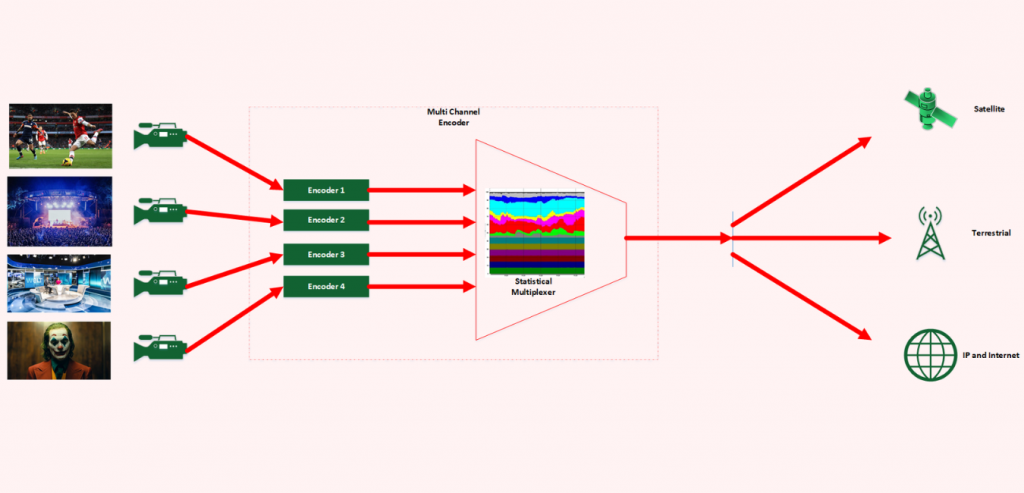
Why This Tech Matters to Me and the Industry?
I’ve been in the broadcasting world for a while, and one thing’s clear: delivering high-quality video without choking on bandwidth is a constant challenge. Whether it’s live sports, streaming dramas, or corporate webinars, viewers want crisp visuals without the dreaded buffering wheel. That’s where multi-channel HEVC encoders come in—they’re like the unsung heroes behind the scenes, making sure everything runs smoothly for broadcasters, IPTV setups, and OTT platforms.
What Exactly Is a Multi-Channel HEVC Encoder?
Picture this: you’re running a TV station with multiple shows or a streaming service with dozens of live feeds. A multi-channel HEVC encoder takes all those video inputs—think camera feeds, satellite signals, or IP streams—and compresses them using the H.265 (HEVC) codec. Compared to the older H.264, HEVC is a beast, squeezing the same quality into about half the bitrate. These encoders aren’t just for one stream; they’re built to handle several at once, which is a game-changer for anyone juggling multiple channels.
What Makes a Great Encoder Stand Out
From our experience digging into gear for studios and streaming setups, here’s what I look for in a solid multi-channel encoder:
- HEVC compression: It’s like magic—same quality as H.264 but uses way less data.
- Flexible inputs: Whether it’s SDI, HDMI, IP, or ASI, it’s gotta play nice with your existing setup.
- Low latency: Nobody wants a delay during a live football match or breaking news.
- 4K and HD support: Because viewers expect crystal-clear visuals, whether it’s one channel or ten.
- Compact yet powerful: A good encoder packs a punch without taking up a whole rack.
- Built for the long haul: It needs to run 24/7 without crashing—reliability is non-negotiable.
Why This Tech Is a Big Deal
I’ve seen firsthand how these Multi-Channel HEVC Encoder can make or break a broadcast operation. For broadcasters, they’re a lifeline—delivering pristine 4K over satellite or fiber without breaking the bank on bandwidth. For OTT platforms like streaming services, they let you scale up your channel lineup without needing a bigger data pipe. Plus, they keep costs down while keeping viewers happy, which is honestly the whole point. I remember working with a regional broadcaster who doubled their channel offerings just by switching to HEVC—it was a total game-changer.
Where These Encoders Shine
Here’s where I’ve seen these encoders do their best work:
- Live TV: Think national networks or local stations pumping out multiple channels at once.
- IPTV and OTT: Streaming platforms use them to send high-quality video to your phone or TV.
- Field production: News trucks and live event crews rely on them to send feeds back to the studio.
- Corporate or government streaming: I’ve helped set up secure streams for company town halls—HEVC makes it look pro.
HEVC vs. the Competition
I’ve had debates with colleagues about HEVC versus H.264 or newer codecs like AV1. Here’s my take:
- HEVC cuts bandwidth needs by about 50% compared to H.264, which is huge for live broadcasts.
- AV1 is promising, but it’s not quite there yet for low-latency needs, and not all broadcast gear supports it.
- For now, HEVC strikes the perfect balance of efficiency, compatibility, and reliability.
Picking the Right Encoder
Choosing an encoder isn’t just about specs—it’s about what fits your workflow. I always tell people to ask:
- Does it work with your inputs (SDI, HDMI, IP)?
- How many channels can it handle in one box
- Is the latency low enough for live events?
- Can it scale as you add more channels?
- Does the vendor have your back with support? (Trust me, you’ll need it at 2 a.m. when a stream goes down.)
What’s Next for Video Encoding
I’m excited about where this tech is headed. From what I’ve seen at trade shows and in the field, here are some trends:
- 8K is coming: It’s niche now, but encoders are starting to handle it.
- VVC (H.266): The next big codec, promising even better compression.
- Cloud-hybrid setups: Mixing on-site hardware with cloud encoding for flexibility.
- AV1 Encoding: offers impressive compression efficiency and is royalty-free
- AI in encoding: I’ve played with some prototypes that use AI to tweak bitrates on the fly—mind-blowing stuff
Wrapping It Up
To me, multi-channel HEVC encoders aren’t just tech—they’re what keep the broadcasting world spinning. They let you deliver top-notch video, save on bandwidth, and scale up without a headache. Whether you’re a small IPTV operator or a global network, investing in a reliable encoder isn’t just smart—it’s how you stay in the game.
